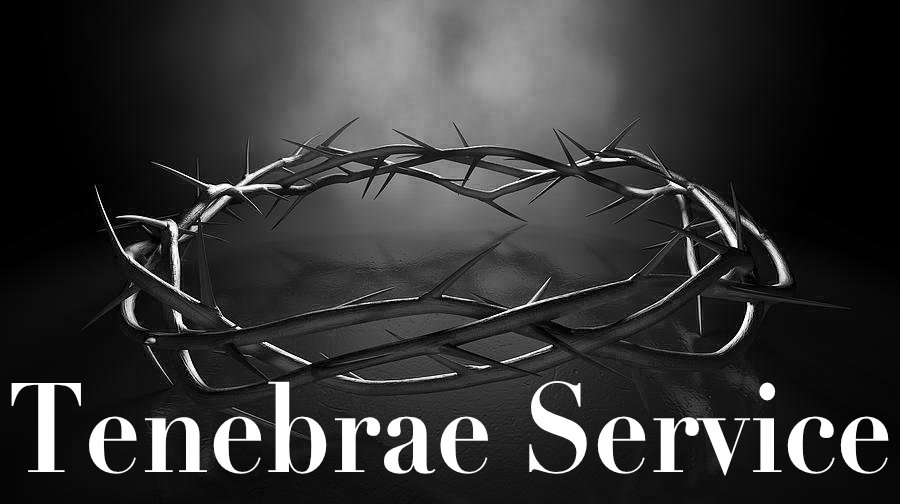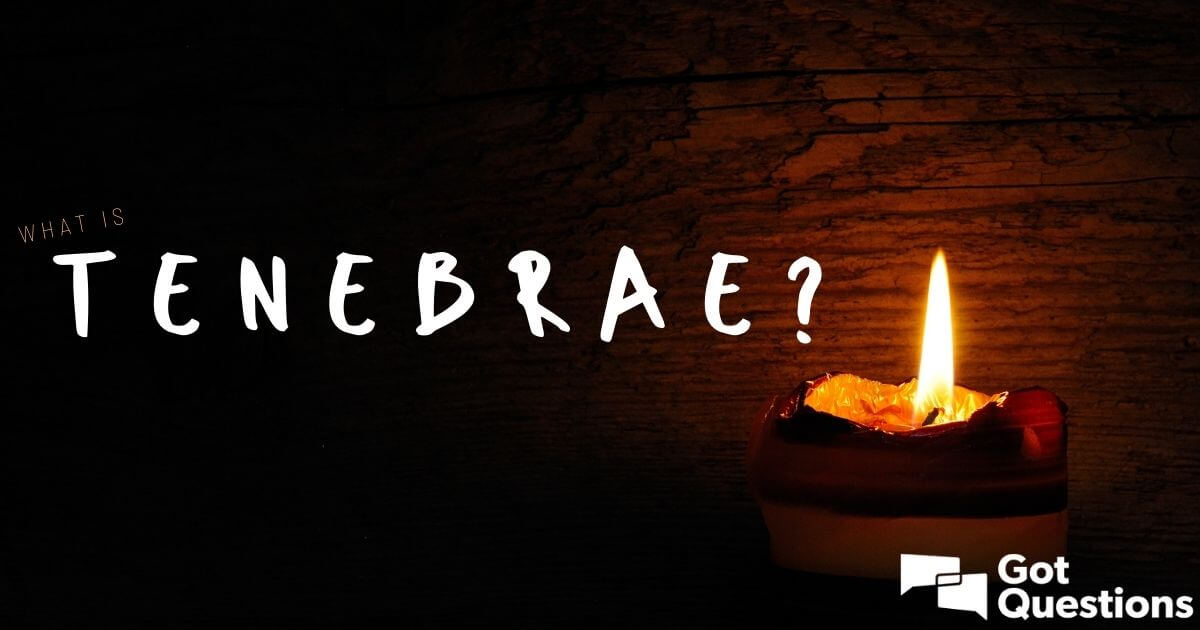Tenebrae Service: The Profound Journey Of Darkness Into Light
There’s something deeply moving about the Tenebrae service. It’s not just a ritual; it’s an experience that takes you through the emotional and spiritual depths of Holy Week. Imagine being surrounded by candlelight, the flickering flames casting shadows on ancient walls as the sounds of lamentation fill the air. This is more than worship—it’s a journey through time, tradition, and faith.
For those who may not be familiar, the Tenebrae service is a powerful Christian liturgical practice steeped in history and symbolism. It’s often celebrated during Holy Week, specifically on Holy Wednesday, Maundy Thursday, or Good Friday. The word "Tenebrae" itself comes from Latin, meaning "shadows" or "darkness," and it perfectly encapsulates the essence of this somber yet transformative ritual.
This service isn’t just about sitting in a dimly lit church. It’s about reflecting on the suffering, betrayal, and ultimate sacrifice of Christ. As the candles are gradually extinguished, the congregation is left in near-total darkness—a tangible representation of the despair that followed Jesus’ crucifixion. But here’s the thing: even in the darkest moments, there’s always a glimmer of hope. That’s what makes the Tenebrae service so profound.
Read also:Vegmovies 2025 Your Ultimate Guide To The Future Of Plantbased Cinema
What Exactly is a Tenebrae Service?
Let’s break it down. A Tenebrae service is essentially a service of shadows, where the church gradually descends into darkness. It’s a time to meditate on the Passion of Christ, focusing on His suffering and death. The service typically involves readings from Scripture, chants, and prayers—all set against the backdrop of diminishing light. Each element plays a crucial role in creating an atmosphere of reverence and reflection.
One of the most striking aspects of the Tenebrae service is the use of candles. Starting with a fully lit sanctuary, one by one, the candles are extinguished, symbolizing the increasing darkness of the world as Christ bears its sins. By the end of the service, only a single candle remains—a reminder of the eternal light of Christ that conquers all darkness.
History and Origins of the Tenebrae Service
The roots of the Tenebrae service can be traced back to early Christian practices, though its exact origins remain somewhat shrouded in mystery (pun intended). Historians believe it evolved from the Matins and Lauds services of the medieval period. These were morning prayer services traditionally held in the dark hours before dawn, emphasizing the themes of night and light.
Over time, the Tenebrae service developed into a distinct ritual, particularly during Holy Week. It became a way for believers to connect with the sorrow and grief of Christ’s Passion while anticipating the joy of His resurrection. Think of it as a bridge between the darkness of Good Friday and the light of Easter Sunday.
Evolution Through the Centuries
Throughout history, the Tenebrae service has undergone various transformations. In the Middle Ages, it was often accompanied by elaborate musical compositions, such as the famous "Tenebrae Responsories" by composers like Tomás Luis de Victoria. These choral works added another layer of emotional depth to the service, enhancing the sense of lamentation and hope.
In modern times, the Tenebrae service continues to inspire and challenge believers. While some traditions have adapted it to suit contemporary tastes, the core elements remain unchanged. Whether you’re attending a traditional Catholic Mass or a more contemporary Protestant gathering, the essence of Tenebrae remains the same: a journey from darkness to light.
Read also:Hyungry Temporary 3 The Ultimate Guide To Shortterm Rental Adventures
Symbolism in the Tenebrae Service
Every aspect of the Tenebrae service is rich with symbolism. From the extinguishing of candles to the hauntingly beautiful chants, each detail serves a purpose in conveying the deeper meaning of the ritual.
- Candles: Represent the presence of God and the light of Christ. As they are gradually extinguished, they symbolize the increasing darkness brought about by sin and suffering.
- Readings: Drawn from the Old and New Testaments, these passages highlight the themes of betrayal, judgment, and redemption.
- Chants: Often referred to as "responsories," these musical prayers express the emotions of grief and hope in a way that words alone cannot capture.
- The Stripping of the Altar: In some traditions, the altar is stripped bare at the end of the service, symbolizing the desolation of the disciples after Christ’s death.
These symbols work together to create a multi-sensory experience that engages both the mind and the heart. It’s not just about hearing the story of Christ’s Passion—it’s about feeling it, living it, and being transformed by it.
Experiencing a Tenebrae Service
Attending a Tenebrae service is like stepping into another world. The dimly lit sanctuary, the haunting melodies, and the profound silence all contribute to an atmosphere of reverence and reflection. If you’ve never experienced it before, here’s what you can expect:
As you enter the church, you’ll notice the soft glow of candles illuminating the space. The service begins with a series of readings, each one followed by a responsory or chant. Gradually, the candles are extinguished one by one, plunging the congregation into deeper and deeper darkness. By the end, only a single candle remains—a symbol of Christ’s enduring presence.
At the conclusion of the service, the lone candle is carried out of the sanctuary, leaving the congregation in near-total darkness. This moment of silence and stillness is often the most powerful part of the experience, allowing participants to reflect on the profound mystery of Christ’s sacrifice.
Tips for First-Time Attendees
If you’re new to the Tenebrae service, here are a few tips to help you make the most of the experience:
- Arrive early to find a comfortable seat and take in the atmosphere.
- Be prepared for a range of emotions—this service is designed to evoke feelings of sorrow, hope, and awe.
- Don’t be afraid to sit in silence and reflect on the meaning of the ritual.
- Consider bringing a journal or notebook to jot down your thoughts and insights during the service.
Remember, the Tenebrae service isn’t just about following along with the liturgy—it’s about engaging with the story of Christ’s Passion in a personal and meaningful way.
Why the Tenebrae Service Matters Today
In our fast-paced, technology-driven world, the Tenebrae service offers a much-needed opportunity for reflection and connection. It invites us to slow down, to sit with the uncomfortable truths of life, and to find hope in the midst of despair.
For many, the Tenebrae service is a reminder that even in the darkest moments, there is always a glimmer of light. It challenges us to confront the realities of suffering and injustice while holding onto the promise of redemption and renewal.
The Relevance of Tenebrae in Modern Times
In today’s world, where distractions abound and attention spans are shorter than ever, the Tenebrae service stands as a counter-cultural practice. It encourages us to unplug, to be present, and to engage with the deeper questions of life. Whether you’re a lifelong believer or someone exploring faith for the first time, the Tenebrae service has something to offer.
Moreover, the themes of light and darkness, hope and despair, are universally relatable. They speak to the human experience across cultures and generations, making the Tenebrae service a powerful tool for fostering community and connection.
How to Plan Your Own Tenebrae Service
Planning a Tenebrae service doesn’t have to be complicated. With a little preparation and creativity, you can create a meaningful experience for your congregation or community. Here’s a step-by-step guide to help you get started:
- Choose a Date and Time: Traditionally, the Tenebrae service is held during Holy Week, but you can adapt it to fit your schedule.
- Select Readings and Chants: Choose passages from Scripture that align with the themes of the service. Consider incorporating traditional responsories or modern hymns.
- Arrange the Candles: Set up a series of candles that can be gradually extinguished throughout the service. Make sure they are safely positioned and easy to access.
- Create a Program: Provide participants with a printed or digital guide outlining the order of service and any special instructions.
- Plan for Silence: Leave space for moments of quiet reflection, allowing participants to process the emotions evoked by the service.
By following these steps, you can create a Tenebrae service that is both authentic and impactful.
Common Misconceptions About Tenebrae
Despite its rich history and significance, the Tenebrae service is often misunderstood. Here are a few common misconceptions and the truth behind them:
- Myth: It’s Only for Catholics. While the Tenebrae service has strong roots in Catholic tradition, it’s celebrated by many Protestant denominations as well.
- Myth: It’s Depressing and Gloomy. While the service does address themes of suffering and death, it ultimately points to the hope of resurrection and new life.
- Myth: It’s Only for Religious Experts. Anyone can participate in and benefit from the Tenebrae service, regardless of their level of theological knowledge.
By dispelling these myths, we can invite more people to experience the beauty and depth of the Tenebrae service.
Conclusion: Embracing the Shadows
The Tenebrae service is more than just a ritual—it’s a journey through the shadows of life toward the light of hope. It invites us to confront the darkness within and around us while reminding us that Christ’s light will always triumph. Whether you’re attending for the first time or have been participating for years, the Tenebrae service offers a profound opportunity for reflection and renewal.
So, why not take the plunge? Find a local church offering a Tenebrae service this Holy Week or consider planning one for your own community. And when the final candle is carried out and the darkness closes in, remember this: even in the deepest shadows, the light of Christ shines on.
What are your thoughts on the Tenebrae service? Have you attended one before? Share your experiences in the comments below, and don’t forget to check out our other articles on spiritual practices and traditions!
Table of Contents
Article Recommendations


